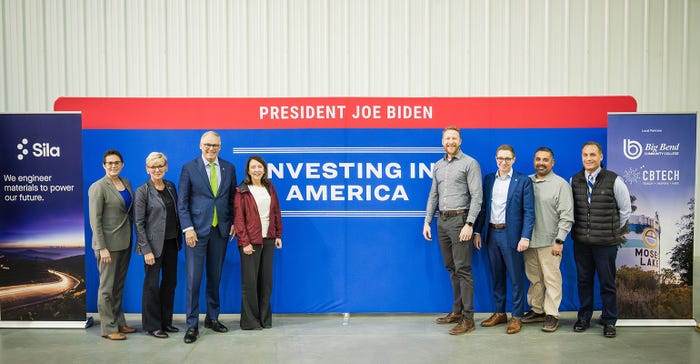DOE, Sila Energize Battery Workforce Education
Discover how Sila and DOE lead US battery manufacturing workforce education initiatives, shaping a sustainable future in clean energy.

The demand for high-performance batteries is increasing rapidly as the world transitions towards renewable energy sources and electric vehicles (EVs) to mitigate climate change and reduce carbon emissions. Battery manufacturing plants are critical infrastructure in this transition, serving as the pillar for the widespread adoption of clean energy technologies. Educating the workforce to meet the specialized needs of these plants ensures that they can operate efficiently, maintain quality standards, and innovate to stay competitive.
The nature of jobs in battery manufacturing plants is becoming increasingly complex and technologically advanced. Modern plants employ automation, robotics, and sophisticated machinery, requiring skilled technicians, engineers, and operators. By investing in education and training programs tailored to these emerging needs, companies can cultivate a workforce with the knowledge and skills to effectively leverage cutting-edge technologies. This enhances productivity and efficiency and ensures safety and regulatory compliance in the manufacturing process.
Moreover, educating the workforce for future jobs at battery manufacturing plants fosters economic growth and resilience in local communities. These plants often anchor industrial clusters, attracting investment, creating jobs, and stimulating secondary industries. By developing a skilled local workforce, communities can capitalize on the opportunities presented by the growing clean energy sector, leading to broader economic benefits such as increased income, improved standards of living, and reduced unemployment rates.
Battery workforce initiative (BWI)
The DOE is collaborating with other government agencies to address workforce challenges in the US battery industry. By investing in workforce development, the DOE recognizes the importance of building a skilled labor force capable of driving the transition to a cleaner, more sustainable energy future.
For example, the Battery Workforce Initiative (BWI) brings together a diverse group of industry leaders and partners to establish nationally recognized training standards. These guidelines aim to bolster the rapid growth of a competitive US advanced manufacturing sector.
Sponsored by the U.S. Department of Energy (DOE), in collaboration with the U.S. Department of Labor, Working for America Institute, Li-Bridge alliance, and other vital stakeholders, BWI is geared towards enhancing the national economy and promoting clean energy supply chains. By assisting employers in meeting the escalating demand for skilled workers driven by significant private investment in this emerging industry, BWI seeks to fortify the domestic workforce and industry landscape.
“American leadership in the global battery supply chain will be based not only on our innovative edge, but also on our skilled workforce of engineers, designers, scientists, and production workers.” Stated Jennifer M. Granholm, Secretary, U.S. Department of Energy.
Sila’s new plan for workforce development
Sila recently announced a new plan for workforce development through a first-of-its-kind education program aimed at training the future battery workforce in Moses Lake, Washington. This program provides hands-on training for technical, mechanical, electrical, and software skills to prepare students for new employment opportunities at its silicon anode manufacturing plant in Moses Lake, WA.

Sila has committed to allocating $1M to each partnering school to offset the cost of equipment and curriculum development. Courtesy of Sila.
Sila's initiative involves partnering with local educational institutions, specifically Big Bend Community College and Columbia Basin Technical Skills Center, to create new multi-course curricula and training programs. These programs will include onsite facility visits, coaching by industry experts at Sila, and hands-on training with newly developed mock equipment.
“Sila has always been focused on moving our breakthrough science and innovation out of the lab and into the real world, and this program is a clear extension of that. We’re helping create real jobs and real educational opportunities that will allow students to get the skills they need for the clean energy jobs of the future,” stated Chris Dougher, VP of Operations at Sila.
The company has committed to allocating $1M to each partnering school to alleviate equipment and curriculum development expenses. The training devised in collaboration with Sila will bolster enrolled students' prospects in careers linked to manufacturing and material science. This includes acquiring proficiency in-process controls and automation for chemical plants, mastering the construction and operation of human-machine interfaces, honing communication skills, ensuring quality control, adhering to safety protocols and regulations, and fostering critical thinking abilities. Upon completing the program, students will obtain certification, qualifying them for entry-level operational and technical roles within a manufacturing setting.
Educating the workforce for future jobs at battery manufacturing plants is crucial for meeting the growing demand for clean energy technologies, fostering economic development, and driving innovation. By investing in education and training programs, companies can cultivate a skilled workforce capable of navigating the complexities of modern manufacturing while contributing to a sustainable future for generations to come.
About the Author(s)
You May Also Like





